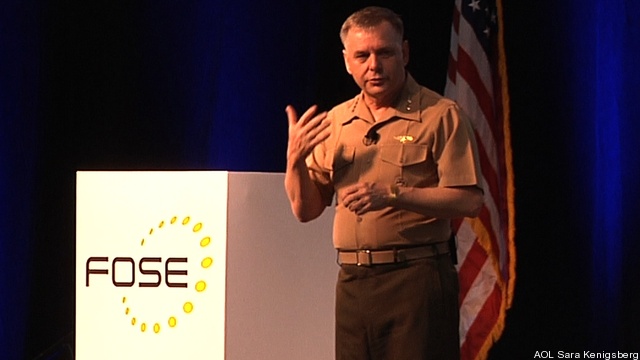Defense IT Stuck In The Stone Age: Cartwright
Posted on

A long-standing reliance on proprietary technology solutions and antiquated acquisition rules have left the Defense Department “pretty much in the stone age as far as IT is concerned,” the nation’s second highest ranking military officer said today.
Marine Gen. James Cartwright, outgoing vice chairman of the Joint Chiefs, said speeding up acquisition cycles is essential if the America is to maintain its military advantage.
He also noted that the evolution of social media and cyber threats have raised new and difficult questions as military leaders respond to conflicts in the world.
“Your collaboration tool is somebody else’s weapon-somebody else’s advantage,” he said starkly, speaking at the 35th annual FOSE Exposition, the nation’s largest government technology trade show, held in Washington, D.C.
“The question in my mind,” said Cartwright, “is what are the implications of groups coming together in minutes and hours, spurred on by unknown event but then they start to rise up and they find cause well beyond any geographic border or nation-state construct?”
He said officials need to look beyond the conflicts. “It’s only telling you something’s coming,” he said. The challenge is to discern, “What is it?”
“We happened to have a huge demographic out there of males, age 17-35, educated, who can’t feed and house their families. And they now have a tool. What are the implications? How do we handle that? Those are questions that we’re trying to work our way through,” he said.
Acquisition
Being able to respond to fast-changing situations has become increasingly difficult for a military that still requires years to deliver new technology solutions, said Cartwright.
“The improvised explosive device is one of the most lethal activities on the battlefield. They invent a fuse, we take 30 days to invent a counter; they invent the next new fuse. The 30 day cycle: It doesn’t really fit well into the annual budgeting cycle…and it doesn’t fit into our acquisition rules and regulations within the Department of Defense,” he said.
Offering an example, Cartwright said, “We’re looking to replace the Humvee. The system wants 14 years to field it. We’re going to cut it in half to seven years.” But he added, with his legendary candor, “We’re going to be irrelevant, really, at the end of the day” at that pace.
“Those kinds of acquisition cycles just aren’t serving us well out there, and we’re going to have figure out how we find that competitive advantage on the battlefield–not after we realize that we’re being taken advantage of, but before, so we can keep ourselves inside the decision loop.”
Cartwright also faulted the trap the military has historically faced, buying proprietary hardware and software solutions, which, once in the battlefield, inevitably require extensive modification.
During the second Gulf War construct, “we put the Marines and the Army down south. Thank God there was a river going north-south that could keep them separate because their radios wouldn’t talk to one another,” he said.
“We have huge numbers of data links that move data between proprietary platforms-one point to another point. These kinds of constructs are leaving us disadvantaged,” he stressed.
Cartwright said the Defense Department is “now starting to move through missile defense and other areas to a construct that says, for command and control, sensors and weapons: Any sensor, any weapon (must work on the system.) We’ve got to get there. We have to understand how to get to a standard schema; how to move information across platforms; how to get out of the proprietary side of the house and ‘advantage’ us on the battlefield.”
Cyber Threats
Threats in cyber space are another reason why the Defense Department must be able to move more quickly.
Cartwright stressed the importance of the Defense Department not isolating cyber space as a domain, the way it did with space, where most in the military was unaware of its activities.
“This is too important for the nation,” he said.
“Our intent this time round,” in creating Cyber Command to coordinate cybersecurity and response activities across the services, “was don’t isolate cyber. Don’t freeze it out. Don’t over-classify it and put it in a corner where nobody knows–except for a few people who invent their own language and their own rules–how to operate it.”
The Defense Department just released last week a brief summary of its strategy for operating in cyber space. Cartwright noted that it serves as a basic framework from which the department – and broader government – can use and build on.
“The cyber strategy is an iterative framework to take us forward in cyber…it’s going to evolve, there’s no doubt about it,” he said.
Cartwright said that the department has developed the architecture to “start to take us where we need to be. We’re pushing hard now to reconcile wired and wireless in the department,” he said, noting that nevertheless, “we have huge numbers of data links that move data between proprietary platforms-one point to another point.”
The question, he said is, “How do you start to mix and match for the problems you actually face rather than the problems somebody dreamed up 15 years ago and now you’re stuck with it?”
Cartwright concluded by stressing the importance for military leaders to stay educated and remain responsive to a diversified population making up today’s military forces–and the burdens their families bear.
This article and video first appeared at our sister site, AOL Gov.
Subscribe to our newsletter
Promotions, new products and sales. Directly to your inbox.
